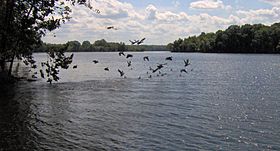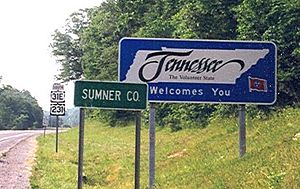Sumner County, Tennessee facts for kids
Quick facts for kids
Sumner County
|
|||
|---|---|---|---|

Old Hickory Lake at Bledsoe Creek State Park
|
|||
|
|||

Location within the U.S. state of Tennessee
|
|||
 Tennessee's location within the U.S. |
|||
| Country | |||
| State | |||
| Founded | November 1786 | ||
| Named for | Jethro Sumner | ||
| Seat | Gallatin | ||
| Largest city | Hendersonville | ||
| Area | |||
| • Total | 543 sq mi (1,410 km2) | ||
| • Land | 529 sq mi (1,370 km2) | ||
| • Water | 14 sq mi (40 km2) 2.5% | ||
| Population
(2020)
|
|||
| • Total | 196,281 | ||
| • Estimate
(2023)
|
207,994 |
||
| • Density | 361.5/sq mi (139.57/km2) | ||
| Congressional district | 6th | ||
Sumner County is a county located on the central northern border of Tennessee in the United States. As of the 2020 United States census, the population was 196,281. Its county seat is Gallatin, and its most populous city is Hendersonville. The county is named after an American Revolutionary War hero, General Jethro Sumner.
Sumner County is part of the Nashville-Davidson–Murfreesboro–Franklin, TN Metropolitan Statistical Area. The county is made up of eight cities, including Gallatin, Goodlettsville, Hendersonville, Millersville, Mitchellville, Portland, Westmoreland, and White House. Sumner County is 25 miles (40 km) northeast of Nashville, Tennessee.
Contents
History
Prior to the European colonization of North America, the county had been inhabited by various cultures of Native Americans for several thousand years. Nomadic Paleo and Archaic hunter-gatherer campsites, as well as substantial Woodland and Mississippian-period occupation sites and burial grounds, can be found scattered throughout the county. The majority of these sites exist along natural waterways, with the highest concentration occurring along what is now known as the Cumberland River. Mississippian period earthwork mounds can still be seen in Hendersonville, and most notably, at Castalian Springs. Long before Europeans entered the area, Native Americans made use of the natural springs for their medicinal and healing properties.
Longhunters traveled into the area as early as the 1760s, following existing Indian and buffalo trails. By the early 1780s, they had erected several trading posts in the region. The most prominent was Mansker's Station, which was built by Kasper Mansker near a salt lick (where modern Goodlettsville would later develop). Another was Bledsoe's Station, built by Isaac Bledsoe at Castilian Springs. Sumner County was organized in 1786, just 3 years after the end of the American Revolutionary War, when Tennessee was still the western part of North Carolina.
During the 19th century, the county was developed for agriculture: tobacco and hemp, and blooded livestock. Numerous settlers came from central Kentucky's Bluegrass Region, where these were the most important products. Middle Tennessee had fertile lands that could be used for similar crops and supported high-quality livestock as well. The larger planters depended on the labor of enslaved African Americans. Infrastructure built to support the housing of slaves during this time still exists in Gallatin.
During the American Civil War, most of Tennessee was occupied by Union troops from 1862. This led to a breakdown in civil order in many areas. The Union commander, Eleazer A. Paine, was based at Gallatin, the county seat. He was notoriously cruel and had suspected spies publicly executed without trial in the town square. He was eventually replaced because of his mistreatment of the people.
In 1873, the county was hit hard by the fourth cholera pandemic of the century, which had begun about 1863 in Asia. It eventually reached North America and was spread by steamboat passengers who traveled throughout the waterways, especially in the South on the Mississippi River and its tributaries. An estimated 120 persons died of cholera in Sumner County in 1873, mostly during the summer. The disease was spread mainly through contaminated water, due to the lack of sanitation. About four-fifths of the county's victims were African Americans. Many families, both black and white, lost multiple members. In the United States overall, about 50,000 persons died of cholera in the 1870s.
On April 17 and 27, 2019, eight bodies were discovered at multiple locations in Sumner County. The sole survivor, left in critical condition, died in 2022 due to major health problems after the injuries. A suspect, identified as Michael Cummins, was arrested for all nine attacks. The case was the worst mass murder in Tennessee in 20 years.
Geography
According to the U.S. Census Bureau, the county has a total area of 543 square miles (1,410 km2), of which 529 square miles (1,370 km2) is land and 14 square miles (36 km2) (2.5%) is water.
Sumner County is located in Middle Tennessee on the state's northern border with Kentucky. The Cumberland River was important in early trade and transportation for this area, as it flows into the Ohio River to the west. That leads to the Mississippi River, and downriver to the major port of New Orleans. Sumner County is in the Greater Nashville metropolitan area.
Adjacent counties
- Davidson County (southwest)
- Macon County (east)
- Robertson County (west)
- Trousdale County (southeast)
- Wilson County (south)
- Allen County, Kentucky (northeast)
- Simpson County, Kentucky (northwest)
State protected areas
- Bledsoe Creek State Park
- Cragfont State Historic Site
- Gallatin Steam Plant Wildlife Management Area
- Old Hickory Lock and Dam Wildlife Management Area (part)
- Rock Castle State Historic Site
- Taylor Hollow State Natural Area
- Wynnewood State Historic Site
Highways
 I-65
I-65 US 31W
US 31W US 31E
US 31E US 41
US 41 US 231
US 231 SR 25
SR 25 SR 52
SR 52 SR 76
SR 76 SR 109
SR 109 SR 174
SR 174 SR 257
SR 257 SR 258
SR 258 SR 259
SR 259 SR 386
SR 386
Demographics
| Historical population | |||
|---|---|---|---|
| Census | Pop. | %± | |
| 1800 | 4,616 | — | |
| 1810 | 13,792 | 198.8% | |
| 1820 | 19,211 | 39.3% | |
| 1830 | 20,569 | 7.1% | |
| 1840 | 22,415 | 9.0% | |
| 1850 | 22,717 | 1.3% | |
| 1860 | 22,030 | −3.0% | |
| 1870 | 23,711 | 7.6% | |
| 1880 | 23,625 | −0.4% | |
| 1890 | 23,668 | 0.2% | |
| 1900 | 26,072 | 10.2% | |
| 1910 | 25,621 | −1.7% | |
| 1920 | 27,708 | 8.1% | |
| 1930 | 28,622 | 3.3% | |
| 1940 | 32,719 | 14.3% | |
| 1950 | 33,533 | 2.5% | |
| 1960 | 36,217 | 8.0% | |
| 1970 | 56,106 | 54.9% | |
| 1980 | 85,790 | 52.9% | |
| 1990 | 103,281 | 20.4% | |
| 2000 | 130,449 | 26.3% | |
| 2010 | 160,645 | 23.1% | |
| 2020 | 196,281 | 22.2% | |
| 2023 (est.) | 207,994 | 29.5% | |
| U.S. Decennial Census 1790-1960 1900–1990 1990-2000 2010–2020 |
|||
2020 census
| Race | Number | Percentage |
|---|---|---|
| White (non-Hispanic) | 155,169 | 79.05% |
| Black or African American (non-Hispanic) | 15,537 | 7.92% |
| Native American | 476 | 0.24% |
| Asian | 2,932 | 1.49% |
| Pacific Islander | 116 | 0.06% |
| Other/Mixed | 9,181 | 4.68% |
| Hispanic or Latino | 12,870 | 6.56% |
As of the 2020 United States census, there were 196,281 people, 70,098 households, and 51,272 families residing in the county.
2010 census
As of the census of 2010, there were 160,645 people, 60,975 households, and 44,593 families living in the county. The population density was 303.68 persons per square mile (117.25 persons/km2). The housing unit density was 115.26 units per square mile (44.50 units/km2). The racial makeup of the county was 89.67% White, 6.42% African American, 1.02% Asian, 0.29% Native American, 0.07% Pacific Islander, and 1.45% from two or more races. Those of Hispanic or Latino origins constituted 3.93% of the population.
Out of all of the households, 26.08% had children under the age of 18 living in them, 57.05% were married couples, 4.37% had a male householder with no wife present, 11.72% had a female householder with no husband present, and 26.87% were non-families. 22.07% of all householders were made up of individuals, and 8.29% were one person aged 65 or older. The average household size was 2.61 and the average family size was 3.05.
The age distribution was 25.29% under the age of 18, 62.10% ages 18 to 64, and 12.61% ages 65 and over. The median age was 38.6 years. 51.20% of the population were females, and 48.80% were males.
The median household income in the county was $54,916, and the median family income was $65,313. Males had a median income of $46,606, versus $35,256 for females. The per capita income was $26,014. About 7.3% of families and 10.1% of the population were below the poverty line, including 13.9% of those under the age of 18 and 9.4% of those age 65 and over.
Education
Public schools
Schools in the county are governed by the Sumner County Board of Education. The twelve-member group consists of eleven elected representatives from each of the eleven educational districts in the county, as well as the Director of Schools. The members serve staggered four-year terms; the Director serves under contract with the Board of Education. The board conducts monthly meetings that are open to the public.
Private schools
- Saint John Vianney Catholic Elementary School (K–8)
- Sumner Academy (K–8)
- John Paul II High School
- Aaron Academy (K-12)
- Hendersonville Christian Academy (PK-12)
- Restoring Hope Christian Academy (PK-12)
Colleges
- Volunteer State Community College
- Union University (Hendersonville Campus)
- Welch College
Communities
Cities
- Gallatin (county seat)
- Goodlettsville (partly in Davidson County)
- Hendersonville
- Millersville (partly in Robertson County)
- Mitchellville
- Portland (partly in Robertson County)
- White House (small part in Robertson County)
Town
Census-designated places
Unincorporated communities
Notable people
Submarine innovator Horace Lawson Hunley was born in Sumner County on June 20, 1823. On October 15, 1863, Hunley, along with seven other crewmen, drowned while making a test dive in Charleston Harbor near Fort Pinckney. Following his death, the submarine, unofficially known as the "Fish Boat," was renamed the H.L. Hunley in his honor. On the night of February 17, 1864, the Hunley sank the USS Housatonic, making it the first submarine to sink an enemy vessel.
Watergate prosecutor and criminal defense trial lawyer James F. Neal was born and raised in Oak Grove and graduated from Sumner High School in Portland in 1947.
R&B National Recording Artist Nacole Rice was born in Sumner County.
See also
 In Spanish: Condado de Sumner (Tennessee) para niños
In Spanish: Condado de Sumner (Tennessee) para niños





